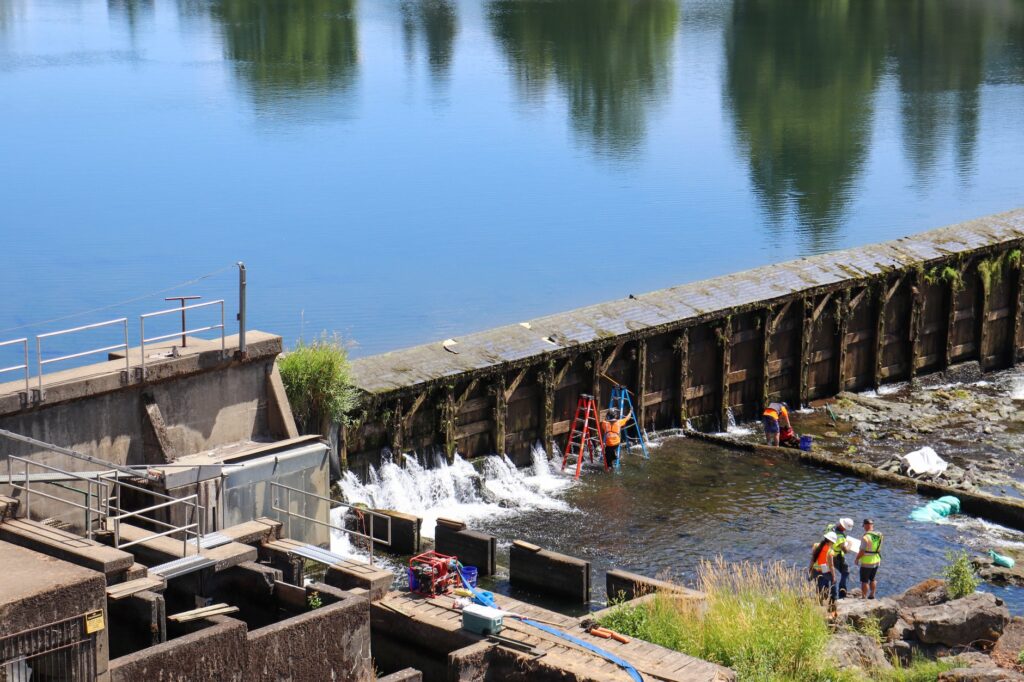By Monique Merrill | Aug. 21, 2025 | Courthouse News
While a controversial southern Oregon dam may delay the migration of a threatened species of salmon, the impact isn’t significant enough to violate federal environmental laws, a federal judge in Portland ruled on Thursday.
“This court concludes that plaintiffs have not proven by a preponderance of the evidence that defendant is liable for ‘take’ of Oregon Coast coho salmon under the Endangered Species Act,” U.S. District Judge Karin Immergut wrote in the 35-page findings of fact and conclusions of law.
A coalition of environmental conservation groups and fisheries organizations led by WaterWatch of Oregon sued the Winchester Water Control District in 2020, accusing the district of violating the Endangered Species Act through its operation of the Winchester Dam on the North Umpqua River. The groups argued the dam causes illegal take of Oregon Coast coho salmon by blocking access to spawning habitat and attracting fish to impassable areas of the dams with leaks.
“This is a disappointing decision, but it doesn’t change the fact that coho salmon are listed under the Endangered Species Act and Winchester Dam needs to come out,” Jim McCarthy, WaterWatch’s southern Oregon program director, said in a statement. “It’s a flawed and outdated dam and the court recognized the dam has significant issues. Our campaign to remove the dam continues.”
Unlike most dams, the Winchester Dam hasn’t produced energy since the 1960s. Instead, it exists solely to create a private flatwater reservoir for the 150-plus homeowners behind the dam, aka the Winchester Water Control District.
The Donald Trump-appointed judge sided with that water control district on Thursday following a five-day bench trial in April.
The environmental groups wanted either full removal of the dam or an order requiring the district to construct a new fish passage facility. Oregon Coast coho salmon have been listed as a threatened species under the Endangered Species Act for decades.
The species has 21 independent populations, with one of those populations relying on the North Umpqua River as critical habitat. The Oregon Coast coho salmon must migrate past the dam to reach spawning areas upstream.
The environmental groups argued that “false attraction flows” were killing and injuring salmon.
In their attempt to find paths around obstacles like waterfalls and rapids, coho salmon jump at flows. False attraction flows refer to flows of water that induce fish to jump without providing a path around the obstacle — in the case of the dam, they are flows that lure fish away from the fish ladder and induce them to jump at other parts of the structure. A fish ladder is a structure designed to provide a series of pools that allow fish to migrate past barriers.
“Although this court credits testimony that coho salmon may jump at the Winchester Dam, this court does not find plaintiffs have proven by a preponderance of the evidence that coho salmon were physically killed or injured as a result of jumping at flows through the dam,” Immergut wrote.
The plaintiffs also argued that the fish expended unnecessary energy by jumping at false attraction flows, which both reduces the likelihood they will successfully spawn and may prevent them from reaching ideal spawning habitat upstream.
However, Immergut wasn’t convinced.
“This court does not find that any delay caused by the dam significantly impairs essential behavioral patterns,” Immergut wrote.
Immergut similarly found that the dam’s fish ladder, though it doesn’t comply with current fish passage standards, isn’t responsible for killing coho.
“The Winchester Dam fish ladder contains a livestream camera and is immediately upstream of a popular park and boat ramp,” Immergut wrote. “This court finds that, if significant fish mortality were occurring at Winchester Dam, it would likely be observable.”
Plus, to succeed in a take claim under the Endangered Species Act, the plaintiffs must show the injury is the kind that the act covers and that the activity directly causes it. Immergut found that while the dam may delay migration, there wasn’t enough evidence to support the accusation that the dam physically kills or injures coho or “significantly impairs” their migration.
The environmental groups’ lawsuit was not the first time the district has been accused of endangering fish.
The lawsuit was put on hold for over a year while the district performed planned repairs to the dam. Following those repairs, the Oregon Department of Fish and Wildlife issued a $27.6 million claim for recovery damages for inadequate fish salvage efforts during construction work in 2023. The agency estimated at least 550,000 juvenile Pacific lamprey were killed during repairs, which far exceeds the district’s authorized take permit of 30,000.
The Winchester Water Control District did not respond to a request for comment before press time.
This article originally appeared on the Courthouse News website on Aug. 21, 2025.

